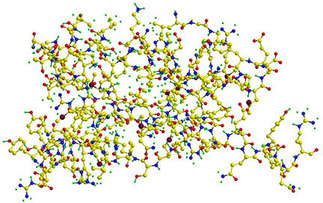 What is it?
Bovine Spongiform
Encephalopathy (BSE) is a deadly neurologic disease of cattle. It’s a
progressive disease with a long incubation period of three to six years and is
identified by the presence of abnormal infectious proteins known as prions. BSE
belongs to the family of transmissible spongiform encephalopathies, which
include scrapie, chronic wasting disease, and other brain affecting diseases.
It was first diagnosed in cattle in the United Kingdom in 1986. There have been
zero reported cases in Minnesota and four cases in the U.S. (Washington, Texas,
Alabama and California).
How is it
transmitted?
There are two types of BSE, classic and atypical. The classic
form is spread through cattle feed that includes meat and bone meal from prion
infected animals. Atypical BSE is rare and spontaneous; it’s unknown how this
form is spread in cattle. This disease and other prion diseases are more
difficult to control because, unlike bacteria and viruses, prions are resistant
to inactivation by heat, freezing, ultraviolet light, or chemical disinfectants.
What are the signs
in animals?
Decreased milk production and weight loss are the primary
signs of BSE in cattle. Other signs indicate
nervous system damage and include behavior changes, lack of coordination,
unusual stance or posture, and difficulty standing from a lying position. These
signs are not unique to BSE and may be caused by other diseases. However, the
surveillance program for BSE in U.S. cattle includes testing animals with these
signs to make sure the disease is not in the U.S. cattle population. The last
time an infected animal was identified in the U.S. was 2012 in California and
it was the spontaneous, atypical, form of the disease.
How is it
diagnosed?
Testing can only be conducted on a dead animal because it requires
examination of the brain in a laboratory to confirm. If a veterinarian suspects
clinical signs of BSE, the animal should be euthanized so the brain tissue can
be analyzed for the disease.
What is the
treatment?
There is no effective treatment or vaccine for BSE.
Euthanasia is recommended after a clinical diagnosis, because animals become dangerous
to themselves, other animals, and humans.
How can it be
prevented?
The U.S. has safeguards in place to prevent this disease
in U.S. cattle. They include prohibiting mammalian protein from rendered
animals going into feed for cattle and other ruminants. The U.S. also places
restrictions on the importation of live ruminants like cattle, sheep, goats,
and certain other ruminant products from countries where BSE was known to
exist.
Is there a risk to
people?
Yes, According to the Centers for Disease Control, “There exists strong epidemiologic and
laboratory evidence for a causal association between [classic BSE and] a new
human prion disease called variant Creutzfeldt-Jakob disease (vCJD),” a
neurological disease in people.
People are at risk if they consume meat from an infected
animal. There are several preventative measures in place to reduce exposure to
this risk. They include the measures to eliminate the spread of BSE infection
in cattle and remove any cattle suspected of BSE infection from the human food
chain. An additional measure is prohibiting the visible neurologic and
lymphatic tissue of all adult cattle from going into the human food chain.
These tissues are where prions concentrate in infected animals. Milk and milk
products are considered safe.
The outbreak of BSE peaked in the early 1990s in the
United Kingdom where it was first identified and where most of the cases
occurred. The U.S. has only found four infected cattle and one of those cases
was the classic form of the disease; no cases have been identified in the U.S.
since 2012. Measures put into place since the 1990s to control cattle feed
ingredients and eliminate the pathway for transmission of the classical form of the
disease.
|